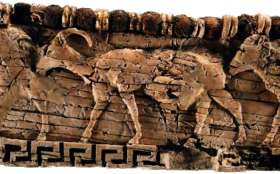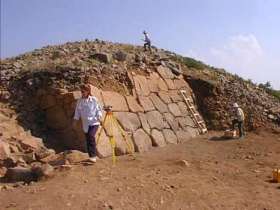This is a summary of a more extensive treatment of the identification of
the city at Kerkenes with Pteria, an imperial foundation of the Medes, mentioned by
Herodotus whose testimony is worth quoting in full:
Croesus, when he had crossed [the Halys river] with his army, came in Cappadocian territory, to what is called Pteria. Pteria is the
strongest part of all that country and lies in a line with the city of Sinope, on the
Euxine Sea. There he encamped, destroying the farms of the Syrians and he captured the
city of the Pterians and made slaves of the people, and he captured all the neighbouring
towns; moreover he drove the Syrians from their homes, though they had done him no manner
of harm. Cyrus, on his side, gathered his own army, and took on, as well, all the peoples
who lived between him and Croesus. (Before he set out to march at all, he sent heralds to
the Ionians and tried to make them desert Croesus. But the Ionians would not listen to
him). So when Cyrus came and encamped over against Croesus, then and there in that land of
Pteria they fought against one another with might and main. The battle was fierce, and
many fell on both sides. At last they broke off at the onset of night, without either
having the victory; so hard did the two armies fight.
 The historical background to the Battle of Pteria begins with the Median
attack on the Neo-Assyrian city of Nimrud in 614 BC, their subsequent alliance with the
Babylonians and sack of Nineveh to the combined forces two years later. Sources for the
following period of Median expansion are few and much debated, being Greek and Babylonian
rather than Median and mostly somewhat later than events themselves. By 590-589 BC the
Medes were fighting the Lydians in Central Anatolia. The power of Urartu must have been
spent because the Median king Cyaxares could not have campaigned towards the Halys River
without security in the rear. The Medio-Lydian war, a series of annual campaigns lasted
into a sixth year when on the afternoon of 28 May 585 BC, it seemingly came to an end with
the Battle of the Eclipse. The historical background to the Battle of Pteria begins with the Median
attack on the Neo-Assyrian city of Nimrud in 614 BC, their subsequent alliance with the
Babylonians and sack of Nineveh to the combined forces two years later. Sources for the
following period of Median expansion are few and much debated, being Greek and Babylonian
rather than Median and mostly somewhat later than events themselves. By 590-589 BC the
Medes were fighting the Lydians in Central Anatolia. The power of Urartu must have been
spent because the Median king Cyaxares could not have campaigned towards the Halys River
without security in the rear. The Medio-Lydian war, a series of annual campaigns lasted
into a sixth year when on the afternoon of 28 May 585 BC, it seemingly came to an end with
the Battle of the Eclipse.
War subsequently broke out between the two countries and lasted for five years,
during which both Lydians and Medes won a number of victories. One battle was fought at
night. But then, after five years of indecisive warfare, a battle took place in which the
armies had already engaged when day suddenly turned into night. This change from daylight
into darkness had been foretold to the Ionians by Thales of Miletus, who fixed the date
for it for the year in which it did, in fact, take place. Both the Lydians and the Medes
broke off the engagement when they saw this darkening of the day: they were more anxious
than they had been to conclude peace, and a reconciliation was brought about by Syennesis
of Cilicia and Labynetus of Babylon, who were the men responsible both for the pact to
keep the peace and for the exchange of marriages between the two kingdoms. They persuaded
Alyattes to give his daughter Aryenis to Astyages, son of Cyaxares - knowing that treaties
seldom remain intact without powerful sanctions.
 The next
part of the story begins with the overthrow of Astyages and the establishment of the
Achaemenid Empire by Cyrus the Great. By this time Alyattes was dead and his son Croesus,
brother-in-law of Astyages, was on the Lydian throne. Turmoil in the Iranian court
provided Croesus with an opportunity. Using the convenient, if not genuine, excuse of the
murder of his brother-in-law, and having sent envoys to various oracular temples from
which he received what he could only interpret as a favorable answer he took his forces
across the Halys River and sacked Pteria, as recounted in the passage from Herodotus
quoted above. After the inconclusive Battle of Pteria between Croesus and Cyrus, Croesus
retreated to Sardis for the winter from where he summoned his allies in the natural
expectation that Cyrus too would withdraw for the winter and that the confrontation would
be renewed in the following spring. Cyrus, however, went in immediate pursuit. The oracle
at Delphi had been correct. An empire was destroyed as a consequence of Croesus's action
but not, as he had so confidently expected, that of the Persians but rather his own. The next
part of the story begins with the overthrow of Astyages and the establishment of the
Achaemenid Empire by Cyrus the Great. By this time Alyattes was dead and his son Croesus,
brother-in-law of Astyages, was on the Lydian throne. Turmoil in the Iranian court
provided Croesus with an opportunity. Using the convenient, if not genuine, excuse of the
murder of his brother-in-law, and having sent envoys to various oracular temples from
which he received what he could only interpret as a favorable answer he took his forces
across the Halys River and sacked Pteria, as recounted in the passage from Herodotus
quoted above. After the inconclusive Battle of Pteria between Croesus and Cyrus, Croesus
retreated to Sardis for the winter from where he summoned his allies in the natural
expectation that Cyrus too would withdraw for the winter and that the confrontation would
be renewed in the following spring. Cyrus, however, went in immediate pursuit. The oracle
at Delphi had been correct. An empire was destroyed as a consequence of Croesus's action
but not, as he had so confidently expected, that of the Persians but rather his own.
 The brief
period of occupation at Kerkenes fits with the historical record: founded soon after 585
BC and destroyed by Croesus some forty years later. The site would be consistent with the
need of Astyages for a strong base east of the Halys River, and the lack of later
occupation can easily be understood because once Cyrus had exerted control over Lydia, the
very reason for a strong base east of the Halys River no longer existed. The brief
period of occupation at Kerkenes fits with the historical record: founded soon after 585
BC and destroyed by Croesus some forty years later. The site would be consistent with the
need of Astyages for a strong base east of the Halys River, and the lack of later
occupation can easily be understood because once Cyrus had exerted control over Lydia, the
very reason for a strong base east of the Halys River no longer existed.
It is striking that Croesus treated the inhabitants of Pteria differently from the
"Syrians" in the surrounding villages who, in contrast to the Pterians, had done
no wrong. It can thus be argued that the phraseology of Herodotus implies that the
inhabitants of Pteria were not the same as the rural population, an implication that can
easily be understood if the occupants of the city were Medes and their allies: a foreign
occupying power.
A much later author, Stephanos of Byzantium lists both Pteria near Sinop, and Pterion
(alternatively Pteria), a city of the Medes. David French has suggested (pers. comm.) that
the association of the name Pterion/Pteria with the Medes supports the identification of
the Median city on the Kerkenes Dag with Herodotus' Pteria.
Source: The Kerkenes
Projekt
|